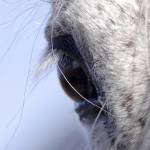Treating Eye Injuries in Horses

Several advances in veterinary medicine have produced improved techniques for treating equine eye injuries. One is the use of amnionic tissue. The amnion, a sac of tissue that surrounds the unborn foal, is collected when a foal is delivered. The amnion is then cleaned, processed with antibiotics, and used as a dressing on corneal wounds. The treatment protects the cornea during healing and reduces infection and scarring.
Corneal transplants are done to replace the entire cornea or only the section of cornea that is badly damaged. This procedure does cause some scarring, but generally the scar is much smaller than it would be if a serious injury was allowed to heal on its own.
Equine recurrent uveitis (ERU), also known as moon blindness, can’t be cured, but disease signs such as excessive tearing, eyelid swelling, and corneal cloudiness can be decreased by treatment. The disease is cyclical, and preventing flare-ups has been difficult. Cyclosporine is effective, but external application by drops or ointment does not allow the drug to penetrate the cornea and conjunctiva to reach the interior of the eye.
Improving on an older model, an improved implant has been designed to allow the slow release of cyclosporine into the tissue between the retina and the sclera (tough outer layer of the eyeball). Not yet approved by the FDA, the implant has been used experimentally and is shown to reduce inflammatory attacks and help to preserve vision in horses with ERU. The device continues to work for three to five years after implantation.








